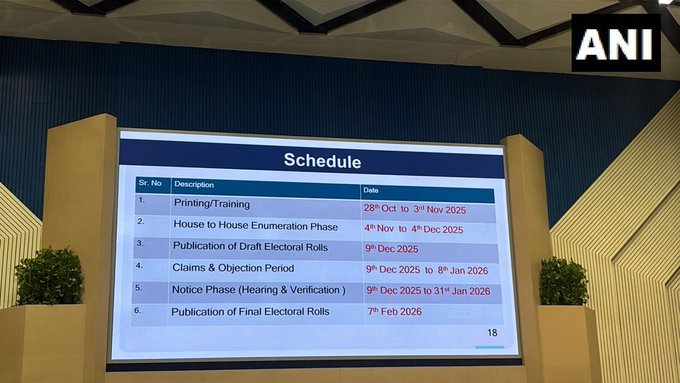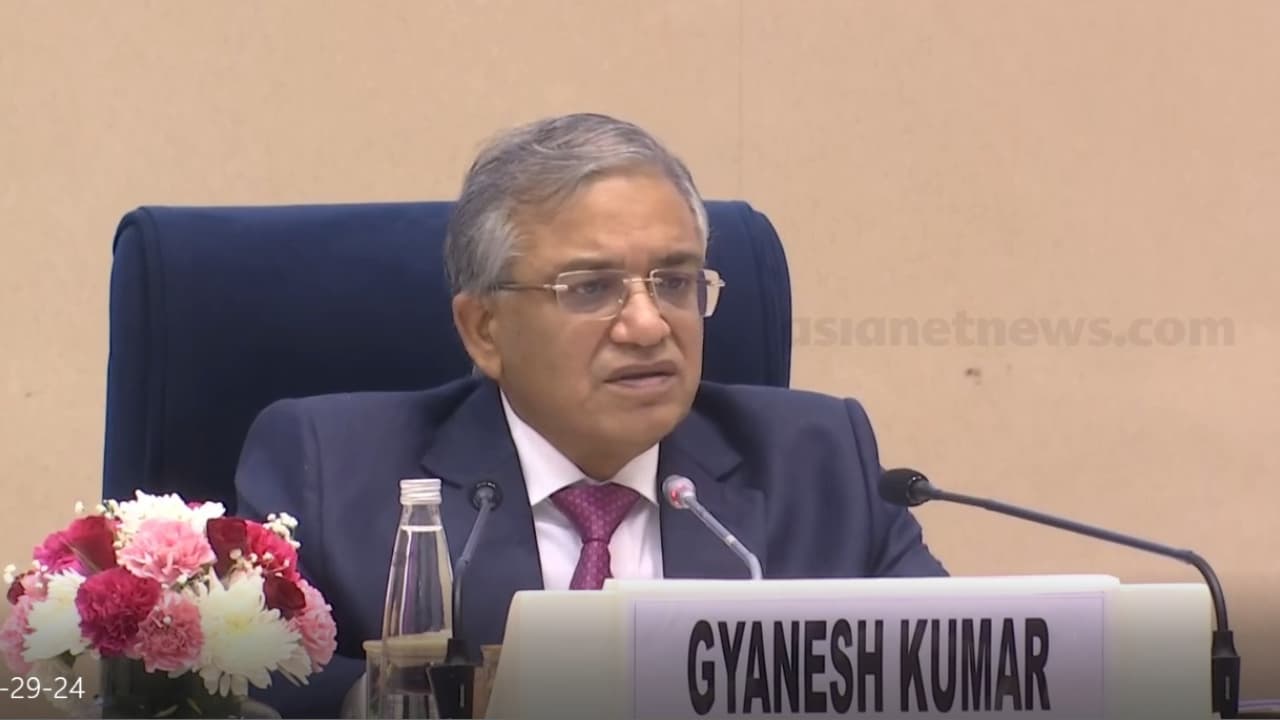EC has started the second phase of SIR of electoral rolls in 12 states and Union Territories after completing the first phase in Bihar. Covering around 51 crore voters, the exercise aims to clean and update India’s voter lists.
The Election Commission of India (ECI) has announced the start of Phase 2 of the Special Intensive Revision (SIR) of electoral rolls. This important exercise will update and verify voter lists in 12 states and Union Territories to ensure accuracy and fairness in future elections. Chief Election Commissioner Gyanesh Kumar announced the plan during a press conference in New Delhi, saying the process would help make India’s voter database more transparent, inclusive and reliable.
Scroll to load tweet…
Scroll to load tweet…
Scroll to load tweet…
What is Special Intensive Revision (SIR)?
The SIR is a large-scale exercise carried out by the Election Commission to check and correct voter lists. It ensures that all eligible citizens are included and that duplicate or incorrect entries are removed.
This is not a new exercise. India has conducted eight such revisions since independence, with the last one taking place between 2002 and 2004. The ongoing revision is the ninth SIR and comes after a gap of more than 20 years.
First phase completed successfully in Bihar
The first phase of the SIR took place in Bihar, covering over 90,000 polling booths. It was completed successfully with zero complaints, according to CEC Gyanesh Kumar.
He praised the participation of voters in Bihar, calling it ‘exemplary’ and said the process would serve as a model for other states.
“The participation of Bihar’s 7.5 crore voters shows how well the SIR can work when people cooperate with officials,” Kumar said.
Phase 2 to cover 12 states and UTs
The second phase of the SIR will be rolled out across the following states and Union Territories:
- Andaman and Nicobar Islands
- Lakshadweep
- Chhattisgarh
- Goa
- Gujarat
- Kerala
- Madhya Pradesh
- Puducherry
- Rajasthan
- Tamil Nadu
- Uttar Pradesh
- West Bengal
Scroll to load tweet…
Among these, Tamil Nadu, Puducherry, Kerala and West Bengal are expected to go to the polls in 2026.
The ECI also clarified that Assam is not part of this phase, as its voter revision will be announced separately due to an ongoing citizenship verification programme under Supreme Court directions.
Key dates for the second phase
The Election Commission has shared a detailed schedule for the entire process:

This means the final updated voter lists will be ready by February 2026.
Voter lists to be frozen before the revision
The CEC also announced that all voter lists in these 12 states and UTs will be frozen at midnight before the revision begins.
This step ensures that no new names or deletions are added during the revision period, keeping the process transparent and organised.
Once frozen, Booth Level Officers (BLOs) will visit households to distribute Unique Enumeration Forms, which contain each voter’s details.
House-to-house verification for accuracy
Every voter will get a pre-filled form showing their details from the existing voter list. The BLOs will visit each home three times to verify the data. Voters will be asked to check if their names, or those of their parents, were included in the 2003 voter list. If found, no additional documents will be required.
For public convenience, voter lists from the 2002–2004 SIR period will also be made available on the official website voters.eci.gov.in, allowing citizens to verify their information online.
According to the CEC, the Special Intensive Revision is necessary to tackle issues such as:
- Migration of voters between states
- Duplicate voter entries
- Inclusion of deceased individuals
- Wrongful registration of non-citizens
He said the aim is simple i.e. to build a clean, inclusive, and credible voter list where every eligible Indian can vote and every name is verified.
No documents required for enumeration
During the enumeration phase, voters do not need to submit any documents. The process will be based on existing records and field verification by BLOs.
However, the Commission has released a list of 12 indicative documents that can be used if additional verification is needed. These include:
- Passport
- Birth certificate
- Permanent residence certificate
- Pension or employee ID from government institutions
- Educational certificates
- Land or house allotment papers
- Caste certificates
- Family registers from local authorities
- NRC entries (where applicable)
The CEC clarified that Aadhaar can be used as identity proof but is not proof of citizenship, date of birth, or domicile.
Training and coordination efforts
To ensure the smooth rollout of the process, training sessions for officials began on October 28, 2025. These sessions prepare Booth Level Officers and Electoral Registration Officers to manage house-to-house surveys and handle online submissions.
CEC Kumar also directed Chief Electoral Officers (CEOs) and District Electoral Officers (DEOs) to meet all political parties in their areas and explain the SIR process. These meetings must be completed “by the day after tomorrow,” ensuring transparency and political cooperation.
Efforts to reach migrated and first-time voters
For voters who have moved to a new place, the ECI has introduced an online form submission option. This will help migrants or new residents to easily verify and update their records without needing to visit their old polling area.
The ECI hopes this feature will increase participation among young and urban voters, who often move cities for education or jobs.
Kerala and West Bengal included for specific reasons
The Commission clarified that Kerala has been included in the SIR because local body elections have not yet been announced there.
Similarly, the inclusion of West Bengal follows discussions between the ECI and the state government. The CEC said there is no conflict between the two, adding, “The Election Commission is doing its duty, and the state government will discharge its responsibilities. States are bound to provide necessary support to the EC.”
Engagement with political parties
The ECI has acknowledged that many political parties have expressed concerns about voter list accuracy in recent years. To address this, the SIR process will be conducted under close supervision, with every assembly constituency monitored by an Electoral Registration Officer (ERO) and several Assistant EROs. Each BLO will handle around 1,000 voters.
This ensures a manageable workload and precise verification.
How India has revised rolls before
Since independence, India has conducted eight previous Special Intensive Revisions in 1951, 1957, 1965, 1971, 1980, 1987, 1995, and 2002-2004.
Each time, the goal has been the same, to keep India’s democracy strong by maintaining clean, up-to-date, and fair electoral rolls.
This ninth revision is the largest in scale, using both offline and online systems to verify more than 51 crore voters.
CEC’s message to voters
In his closing remarks, CEC Gyanesh Kumar urged every eligible citizen to take part in the verification process.
“This is your right and your duty,” he said. “Our goal is to make sure that no eligible voter is left out and no ineligible name remains on the rolls.”
He added that the successful completion of the SIR would strengthen trust in India’s democratic process, especially as several key state elections and the next general election approach.
A step toward cleaner, stronger elections
The Special Intensive Revision is more than a routine update, it is a nationwide effort to renew confidence in India’s democracy.
With field officers visiting every home, digital verification tools online, and clear timelines in place, the Election Commission is aiming for a voter list that is accurate, inclusive, and transparent.
By February 2026, when the final lists are published, India’s electoral system will be better prepared for the many elections to come, giving every citizen a voice that truly counts.
(With ANI inputs)
